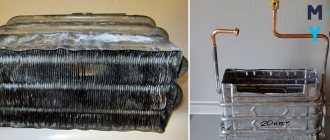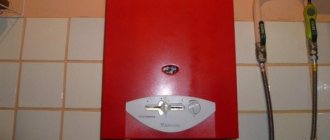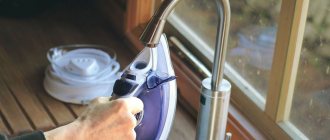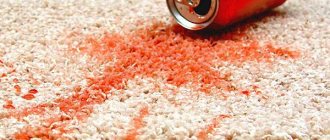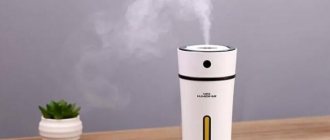Methods for cleaning an instantaneous water heater
Cleaning a gas water heater does not always mean complete disassembly, down to the screw. But one issue is the prevention of a completely serviceable unit, and a completely different one is the removal of many years of scale from the coil and soot from the burner. A instantaneous water heater can be serviced in the following ways:
- completely disassemble the column, clean the gas burner device and rinse the copper heat exchanger;
- flush the radiator without disassembling;
- clean the working elements of the unit from soot and contaminants - igniter, electrodes, water unit (in common parlance - “frog”).
Note. The passage holes of the “frog” become clogged quite rarely. Usually they are cleaned when it is necessary to disassemble and repair the water unit, for example, to replace an unusable membrane. The design and principle of operation of the elements of a water heating column are described in detail on this page.
Diagram of an instantaneous water heater using natural gas
If the device has been operated for many years without maintenance, the channels are half clogged with scale, and the flame of the gas burner has turned yellow from blockages, then the first option is definitely implemented - complete disassembly. A similar decision is made when it is necessary to solder a leaky radiator.
Preventative flushing of the heat exchanger of a household water heater is carried out without dismantling (method No. 2). Local soot removal (option No. 3) is carried out when the ignition system malfunctions - the igniter barely burns, there is no spark at the electrodes, loud pops are heard in the combustion chamber when the burner starts.
Why is it clogged?
The reason for such contamination lies in the operating principle of the device. The device heats water using gas, and therefore accumulations of soot and deposits cannot be avoided. In addition, the incendiary element itself very often becomes dirty, collecting soot on its wick.
But the real apocalypse comes when scale “settles” in the water heater pipes. It not only interferes with the normal operation of the equipment, but can even disable it completely, completely clogging the water supply part. The appearance of scale in the heat exchanger is especially dangerous.
The heat exchanger is a collection of tubes placed above a gas burner. Water must flow through them constantly and unhindered; it is in them that it heats up evenly. When scale accumulates in these pipes, interruptions in the supply of hot water occur.
How to descale a column
What kind of products do not the owners of private houses and apartments use when cleaning geysers with their own hands - various acids, household chemicals and even electrolyte from batteries. We warn you: most of these compounds are unsuitable for servicing water heating devices; their use will not give results, and can easily cause harm.
We will recommend 2 products whose effectiveness has been tested in practice and confirmed by numerous user reviews:
- An inexpensive powder sold in grocery stores is food-grade citric acid. 50-70 grams of product are diluted in 1 liter of washing water.
- Special liquids designed for cleaning the coils of geysers and plate heat exchangers of double-circuit boilers from scale.
Note. In particularly advanced cases, it is allowed to increase the concentration of citric acid to 100 grams / 1 liter.
Scale is a combination of salts of various metals, representing solid deposits of a light shade. Hydrochloric, sulfuric or acetic acid weakly dissolves this substance, but happily “eats” copper. But the cheap “lemon” works flawlessly, as you can see by watching the comparison video:
Indications for the procedure
The column needs to be cleaned for a number of reasons:
- The first is scale. The scale itself does not bother anyone, since it does not have a harmful effect on the body. However, scale serves as an additional wall between the flame and water, and a wall with low heat transfer rates. That is, accumulated scale impairs heat transfer, and the water cannot warm up normally. This is especially true for flow columns. Secondly, scale reduces the cross-section of the water tube, thereby increasing the potential energy of the flow. Simply put, the pressure in the column pipes increases, which can lead to either a complete cessation of operation of the device or to the rupture of all tubes in the column.
- The second reason is soot on the heat exchanger. In general, soot on one side and scale on the other can literally reduce heat transfer to zero. Boiler houses combat this with a complex water purification system, but installing such a system in an apartment or private house is not cost-effective. Therefore, it is better to simply clean the column from time to time.
- The third reason is contamination of the wick with soot. This leads to incomplete combustion of gas, which, firstly, is not economical, and secondly, increases gas consumption.
- The fourth reason is the chimney becoming clogged with the same soot. Possible consequences: the draft overturns and, as a result, the device stops working, or even gas enters the apartment.
Cleaning the heat exchanger of a gas water heater
Well, now, if we understand the reasons, let’s talk about how to understand that the water heater needs cleaning.
Full disassembly service
Do not be afraid to disassemble the water heating installation, the procedure is not that complicated. You will need the most common tools - screwdrivers, pliers, standard wrenches. What to do before starting work:
- Close the taps of the cold water, hot water and gas supply pipelines. Unplug the turbocharged dispenser from the outlet.
- Substituting the container, unscrew the union nuts (American) on the connection of the water pipes. Disconnect the connections from the unit without losing the rubber gaskets.
- For convenience, it is recommended to remove the gas heater from the wall. It is not easy to disassemble and clean a unit that is hung too high or installed in a narrow niche.
- To dismantle the water heater, disconnect the gas line and the chimney pipe. Remove the unit from the hooks.
Lay the hot water column on a horizontal surface and proceed to further work, the order of which is outlined in our instructions.
How to remove the heat exchanger and column burner
We will show the disassembly sequence using the example of a cheap Chinese Novatek water heater. We present step-by-step instructions with photos:
- Remove the control handles mounted on the front panel. Unscrew 2 screws (or 2 plastic clips) and remove the device casing.
- The next step is to remove the smoke collector. To do this, disconnect the wires from the draft sensor and unscrew the screws holding the diffuser box.
- Disconnect the heat exchanger tube from the water unit by disassembling the connection with the union nut. The second pipe must be freed from the lock washer, pressed with 2 screws.
- Disconnect the burner from the gas valve by unscrewing the 2 screws on the flange. Having moved the radiator upward, carefully remove the burner device (pull towards you) and move it to the side.
- Unscrew all screws connecting the heat exchanger to the rear panel of the water heating unit.
- Pull out the radiator completely and remove the burner, disconnecting the wires along with the ignition electrodes.
Note. While removing the heat exchanger, disconnect the wires from the temperature sensor.
Disassembly of geysers from other manufacturers may differ, but not fundamentally. The order of work remains unchanged. Let's list some important points:
- in a chimneyless turbo column, the fan will have to be removed;
- in units of the Italian brands Ariston (Ariston) and some others, the pipes are connected not with nuts, but with self-clamps;
- If the water heater is equipped with an igniter, then before removing the burner it is necessary to disconnect the gas tube connected to the wick.
Important! Be careful not to lose any rubber or other gaskets discovered during disassembly. Before assembling and installing the column, it is advisable to replace these seals with new ones.
Our expert plumber will demonstrate the above process in detail in his video:
Flushing procedure
This operation is very simple compared to disassembly - cleaning the gas water heater begins by immersing the heat exchanger in a container with washing liquid. The procedure is as follows:
- Take a bucket or deep basin, fill it with water and prepare a cleaning solution according to the recipe on the package. The concentration of citric acid is 50-70 grams per 1 liter of liquid.
- Immerse the heat exchanger in the container with the radiator down and the pipes up.
- Using a watering can, fill the coil with detergent. Rinse it periodically by adding new solution.
- Flush the heat exchanger until clean liquid comes out of the tubes without scale flakes. Then run tap water through the coil to remove any remaining product or impurities.
Advice. Using citric acid, heat the solution to a temperature of 50-60 °C. The reaction will be more intense and end faster.
The removed burner can be cleaned from the outside and purged or washed with a solution of citric acid (no more than 50 grams per liter of water). Finally, rinse the element with running water, blow with compressed air and dry thoroughly. Do not ignore other parts of the gas water heater - the mesh filter, smoke collector and combustion chamber, remove soot and other contaminants from them.
After washing and drying, put the heat exchanger back in place, connect the burner and follow the remaining steps to reassemble the water heater. It is important to achieve tight connections: when installing old gaskets, treat them with high-temperature sealant. Check the joints for tightness using water pressure (4-6 bar).
It wouldn’t hurt to blow out the inside of the burner with compressed air at a pressure of 4-6 bar
For reference. The duration of washing depends on the thickness of the scale layer inside the column heat exchanger and ranges from 2-3 hours (prevention) to 2 days.
How to remove scale without removing the radiator
To perform this procedure, simply remove the front panel of the water heater and disconnect the heat exchanger tubes from the water unit. Do not ignore the second step and do not rinse the coil together with the “frog”! You don’t know how the detergent will affect the membrane and other parts of the water valve, so it’s better not to take risks so as not to repair the unit later.
There are 3 ways to internally flush a heat exchange device:
- Connect hoses to the heat exchanger pipes and pour the cleaner manually through a funnel.
- Remove the gas heater from the wall, turn it upside down and place it on the floor. Periodically pour a solution of citric acid into the coil and wash away the scale with water through the hoses.
- Make a booster from a heating circulation pump - a device for pumping liquid through a heat exchanger. The scheme is simple: a pump, connecting hoses and an open container with detergent.
Recommendation. To protect the circulation pump of a homemade booster from contamination, install a mesh on the suction pipe to catch dissolved scale.
The burner and the chamber of the gas water heater will have to be cleaned with a brush with long soft bristles. Use a household vacuum cleaner to remove dust.
Cleaning products: folk and household chemicals
It is better to clean the heat exchanger at home using simple means: citric acid or special cleaning powders, gels or liquids. Some people use solutions of inorganic acids, for example, hydrochloric acid, but this is not recommended, since it can dissolve copper, which is contained in the parts of the gas column, causes an oxidation reaction, and corrodes the walls to the point that cracks may appear.
Some folk remedies also help clean the radiator and other elements of the unit. Citric acid is considered the most effective remedy. To clean, citric acid powder (60 g) is diluted in half a liter of water, the water is heated with a radiator for 30 minutes, then washed with plenty of running water.
We service the igniter and water intake unit
If there is a need to clean the water unit, do not rush to disassemble the entire device. Take a look at the operating instructions for the water heater, find the “frog” in the diagram and follow the following algorithm:
- Remove the adjuster knobs and front cover.
- Dismantle the water unit by disconnecting the pipes.
- Unscrew the screws holding the cover, remove it and get to the membrane.
- Clean the filter - mesh and water holes in the frog body using a wooden stick or soft copper wire. Remove scale with a brush.
- Rinse the parts with water and assemble the assembly. Replace damaged or cracked membrane immediately.
Clean the pilot burner jet (wick) with thin copper wire or a toothpick moistened with alcohol. Wipe the ignition electrodes and the flask of the flame sensor (thermocouple) thoroughly from soot, otherwise over time the column will begin to turn off spontaneously.
When to clean a gas water heater
Information about the frequency of cleaning geysers is quite contradictory. Some sources on the Internet recommend maintenance annually, others – once every 6 months, and so on. The homeowner will be guided correctly by the quality of tap water and some signs indicating that the device is dirty:
- heating efficiency and pressure in the DHW line have decreased - the heat exchanger is clogged;
- the pilot light burns with a yellow or red flame (should be blue);
- the color of the fire on the main burner also changed;
- the column does not ignite and turns off on its own at normal pressure in the network.
The average interval between preventive cleanings of instantaneous water heaters is 1 year. But the quality and hardness of the local water should be taken into account. If it is saturated with salts, scale will be deposited much faster. In such cases, it is appropriate to use filter softeners, otherwise all water heating equipment will quickly become unusable.
Reasons for heat exchanger failure
The period of operation is determined primarily by how the water in the city water supply is disinfected. In Russia, either pure chlorine or chlorine dioxide is used. When the water flowing through the copper tube heats up, it causes a violent chemical reaction. Copper chloride is inferior to pure metal in strength, and therefore fistulas appear quite quickly. The luckiest people are residents of cities where tap water is ozonated.
But there are still very few such settlements. The high cost of the modern solution does not allow us to count on the rapid spread of ozonation. Moreover, now manufacturers have begun to save in every possible way. And if previously troubles happened quite rarely with thick tubes of heat exchangers, now thin, low-quality copper is used everywhere. The service life of products has significantly decreased.
